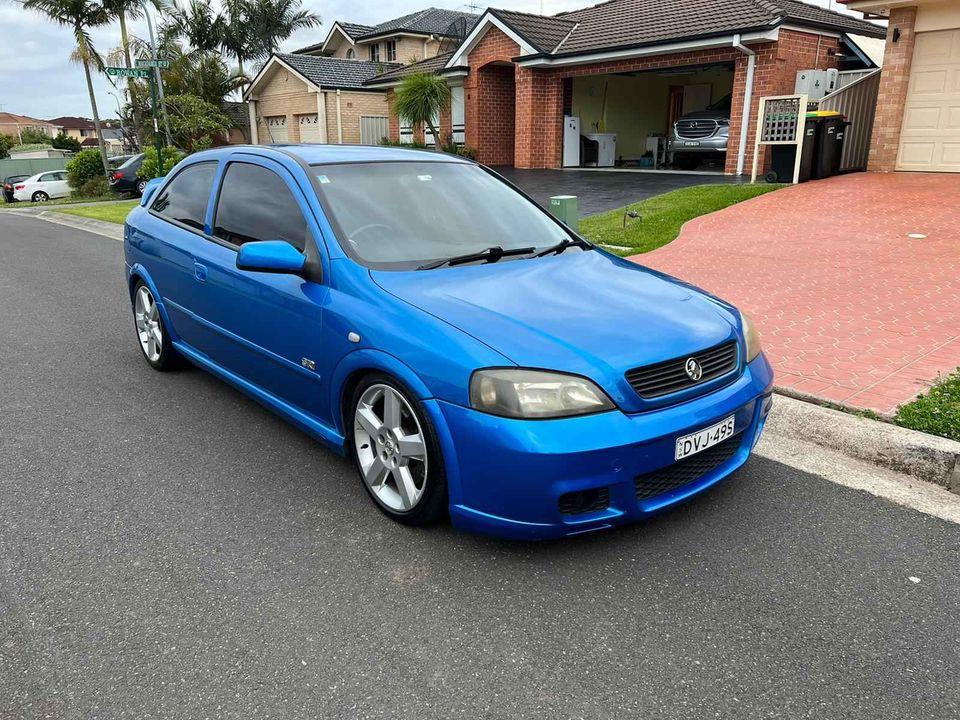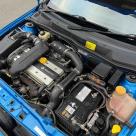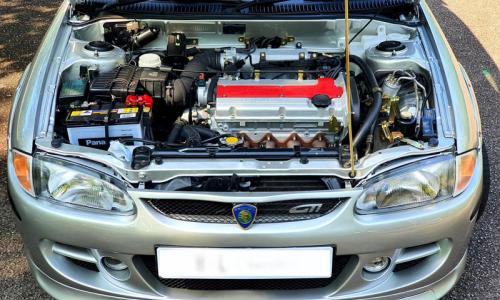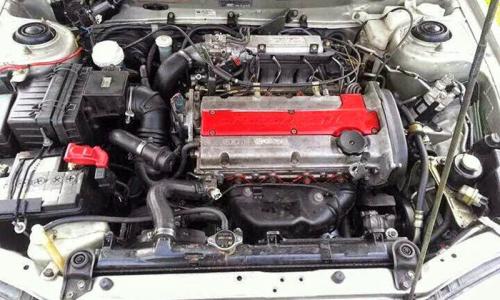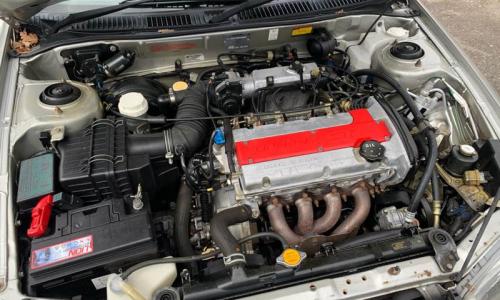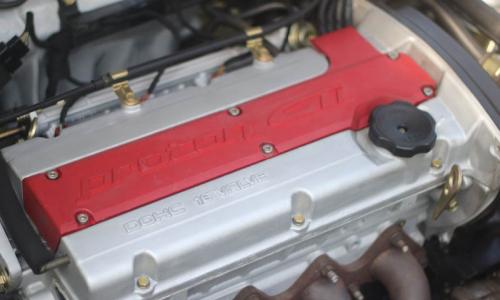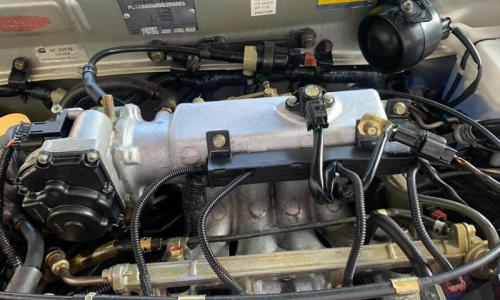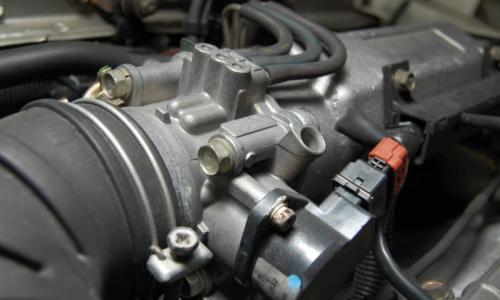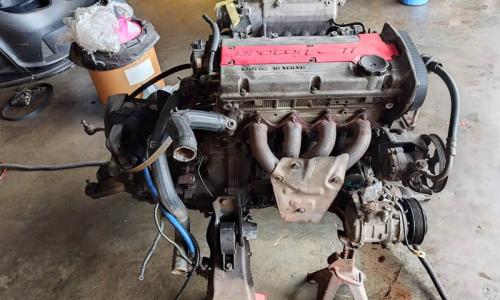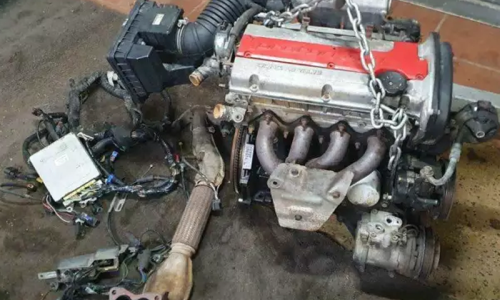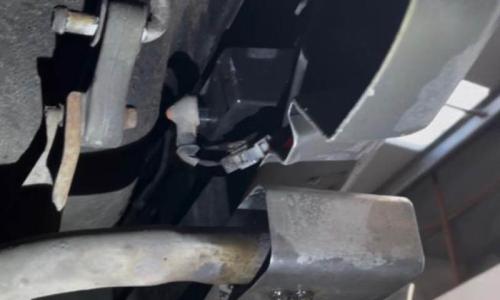For sale: 2003 SRi Turbo Astra Holden
Specifications
In this section of the guide we detail the mechanical specifications for the Satria GTi. This section includes details of the change to the engine Electronic Control Unit (ECU), which in early cars was a Mitsubishi (MMC ECU), and in later cars was a Siemens ECU. Please note, power specs may differ to those quoted below as a result of the ECU changes. If you have further information / clarity on the power specs, please do get in touch.
Engine and performance specs:
- Inline 4-cylinder 1.8l (1834cc) DOHC 16-valve non turbo
- Compression ratio: 10.5:1
- Nore / Stroke: 81mm x 89mm
- Power:
- 103kw @ 6,000 RPM & 164Nm torque at 5,500 RPM (non-emission controlled).
- 99kw @ 6,500 RPM & 162Nm torque at 5,500 RPM (emission controlled markets including UK).
- 0-100 km/hr: 7.8 seconds (early MMC ECU cars); 8 - 9 seconds: Later Siemens VDO ECU cars).
- Top speed: 210km/hr (MMC ECU); 190km/hr (Siemens VDO ECU).
- Fuel economy: 6.6l/100km.
- Fuel tank capacity: 50 litres.
- Gearbox ratios:
- 1st: 3.083:1
- 2nd: 1.947:1
- 3rd: 1.285:1
- 4th: 0.939:1
- 5th: 0.756:1
- Reverse: 3.083:1
- Final drive: 4.322:1
Handling:
- All independent suspension. McPherson strut setup in front and multilink in the rear. Coil springs, dampers and stabiliser bars applied front and rear.
- Increased body rigidity due to use of foam filler in strategic areas.
- 14-inch servo power assisted disc brakes on all wheels, ventilated at the front.
- ABS brakes.
- 16 inch alloy wheels (6.5J x 16) with 45 series Michelin radial tyres - 204/45R16.
Dimensions:
- Height: 1,365mm.
- Width: 1,710mm (including wheel arches).
- Length: 3,995mm.
- Wheel base: 2,440mm.
- Turning circle: 5.6 metres.
Mitsubishi Motor Co ECU (MMC ECU) vs Siemens VDO ECU
One of the most confusing topics we discovered when researching the GTi is the ECU, and the changes that were made throughout production. There appears to be a big preference for the earlier MMC ECU cars, which have more power, higher top speed, and are supposedly more tuneable. Below we have summarised the difference between the ECUs based on our review of forum discussion, which will hopefully assist enthusiasts in understanding why there is so much talk about the ECU changes in the GTi.
1. MMC ECU
The MMC ECU was fitted to early GTis, up to some point in mid- 2001. We have not been able to confirm a precise changeover date, and there is some debate around it.
In 1999 cars, the MMC ECU was adapted to run without a catalytic converter. As a result, these very early non-cat cars are the best performers. For the 2000 model year, the MMC ECU was detuned slightly to meet emission standards for export markets (such as Europe and Australia), and ran with a cat converter and oxygen sensor. We presume that these cat-converter compatible MMC ECUs were the ones that delivered the performance specifications for the GTi that were quoted in most magazines at the time (i.e. 0-100 in 7.8 seconds, and a top speed of >200 km/hr).
These earlier MMC ECUs are often preferred by enthusiasts not only due to the greater factory power output, but also because they are considered simpler to modify by tuners.
The MMC ECU can be tuned with piggyback modifications. It is a simpler ECU which can be manipulated easily in comparison to the Siemens VDO ECU. The MMC ECUs use a mass air flow sensor to read the incoming air charge. Based on the air charge, it determines the injector duty cycle. Therefore, if you plug in higher flow injectors, your engine will run richer all the time. Plug in lower flow injectors, and your engine runs leaner all the time (i.e. the injector cycle is static despite the change). Tuning on this sort of ECU involves only the manipulation of mass air flow output. By altering the mass air flow signal provided to the ECU, it fools it into using a different injector duty cycle, which can be used to get more from the engine.
2. Siemens VDO ECU
This ECU is believed to have been fitted to cars from late 2001, through to the end of GTi production. Again, this is the subject of some debate.
This ECU has received criticism as it reduced the GTi's factory performance specifications (0-100 in 8 seconds or slower, and top speed dropped to about 190km/hr or less). The engine's redline with this ECU also dropped from 7,500 to 6,500rpm.
The Siemens ECU is considered a 'smarter' and more modern ECU in comparison to the MMC ECU. However, that has also resulted in it being more difficult to modify because it does not respond to 'piggyback' modifications like the earlier MMC ECU. This ECU can be modified, but according to forum discussion it is a bit more difficult to do.
Unlike the MMC ECU, the VDO ECU uses the lambda sensor for closed-loop operation at idle and up to around 3,500rpm. Within this closed loop system, the injector duty cycle is based on the air-fuel ratio. So if you want to tune the VDO ECU up to 3,500rpm, you need to intercept the lambda sensor value. From 3,500rpm upward, it uses a MAP sensor that uses manifold vacuum to determine airflow. The VDO ECU goes into an open loop mode similar to older ECUs and you will need to alter the MAP sensor signal to alter performance.
The Siemens VDO ECU has the added advantage of a built-in knock sensor that ties back to the ignition advance mechanism. Therefore, engine knocking due to a lean mixture can be mitigated by the Siemens VDO ECU which will compensate by enriching the fuel mixture.
There are some great comments at the following link where most of the above information was sourced:
https://forum.lowyat.net/topic/834280/+60
Vehicle location
Australia , NSW , Sydney
These have become somewhat a forgotten performance hatch of the early 00s, but I think they deserve some attention. The Astras were one of the best looking hatches of their era - certainly the best proportioned hatch of the time, and combined with a decent body kit, lowered, and a performance turbo engine, there's a lot to like about these 20-year old hot hatches..
This one came up on Facebook Marketplace in January 2023, asking $7,490. It has 185,000km on the odometer, and looks fairly well looked after. The seller at the time noted that it had just been serviced and came with all new tyres. Not a bad package for that price, and in the best colour of the range.
I think this is the first Astra SRi Turbo on our register - will try and see if we can get a few more of these on here. A bit more unique than a Golf GTi, and classier than a Satria, and it's power was very decent too at 147kw. Bargain I think. See the original advertisement here.
